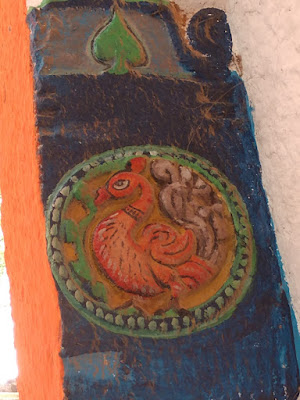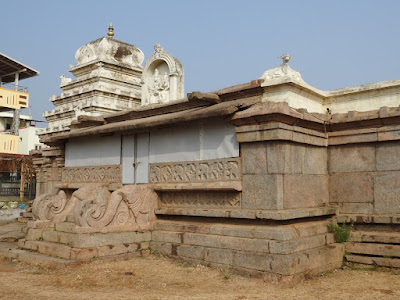Chelur is a small town in Tumkur district. A small one but its location is strategic. Basically the town is a junction of five roads and known for it's coconut market. People traveling from Nittur to Sira have to pass through Chelur. I'd driven through it in Jan 2023 while driving from Bhogasandra to Dharwad. The town's commercial significance was obvious. I was ignorant of it's historical monuments until my friend Siddaramanna told me about the town's gateway and a prophecy attached to it. That sparked curiosity about the place. Also I was told about a Kalyani and Maralu Siddeshwara Devastana.
Jan 20, 2024. After a 3-day gathering of school friends at Sridhar's farm at Bhogasandra, I was heading back to Dharwad. Bhogasandra to Chelur is just 17 km but took about 25 minutes because of rural roads passing through several villages. The coconut-betelnut belt of Tumkur district extends up to Chelur. At the five-road junction of Chelur, I got directions to Cheluru Ooru Bagilu which means Cheluru town gateway. To me the name Cheluru brings scorpions to mind because Kannada word for scorpion is Chelu. That's my imagination, Chelur may not have any historical connection to scorpions.
So here we are looking at the historical landmark of Chelur, probably built during Hoysala or Vijayanagara period. Some people of the town have taken steps to protect the monument but then there are people who don't realize its importance.
Chelur Ooru Bagilu seems like a stone-mortar structure originally. Now it's covered in a thick layer of enamel. As you see two bikes are parked inside. People living around use this monument like personal property.
Presently the spaces within this gateway are being used offices of some public department. On the left hand side wall the popular quote of Chelur in text.
Below is the transcription of the quote:
ಚೇಳೂರು ಊರು ಬಾಗಿಲು ಕಲ್ಲುಕೋಳಿ ಮೇಲ್ಪಾಗದ ಬಂಡೆಯಲ್ಲಿದೆ
ಅರಳೀ ಮರದ ಎಲೆ ಬಟುವಾದಾಗ
ಚೇಳೂರು ಬಾವಿ ತುಂಬಿ ಹರಿದಾಗ
ಕಲ್ಲು ಕೋಳಿ ನೇರವಾಗಿ ನಿಂತು ಕೂಗಿದಾಗ
ಮರಳು ಬಸವಣ್ಣ ಎದ್ದು ನಿಂತು ಗುಟುರಿಕೆ ಹಾಕಿದಾಗ
ಪ್ರಪಂಚ ಪ್ರಳಯ
Here's the rough translation of the above:
The time when Peepul leaves become rounded, the stepped well overflows, the stone fowl stands erect and crows, and the sand bull stands up and bellows, this world will end.
Here's the sculpted stone fowl on one of the columns inside the gateway.
The space on the opposite side seems to be used like a store room.
The gateway is oriented in the east-west direction. This is the western side, behind me is the older parts of Chelur.
This gate is actually situated on the eastern side of the town, however presently it may seem center of the town since the town grown with time. A vegetable vendor has erected a shelter for his shop right next to the monument. What an eyesore!
I move on to see the two other items mentioned in the quote- the well and sand bull. The well is just 400 meters away, any local person can give directions to these spots. The sight of the stone well made me sad. People simply don't care for heritage.
Going by the stone wall around the well, one can tell it's an ancient structure. The well is situated on a raised ground on which is a small temple and a larger temple under construction.
The plight of the stepped well is pathetic, a jungle grown into it. Roots will dislodge the stone slabs and eventually the walls will collapse. Since the well was dry, it's bottom was visible.
Close to one of the corners of the well I saw stone steps descending into the ground. I thought these steps could be connected to the well, but when I checked the well again I couldn't see any opening in the walls.
This small structure is Bairaveshwara Devalaya, an active shrine. In the background is the construction site of a larger temple, probably for Bairaveshwara.
One final look at the walls around the wall. One of the articles on Chelur says this well was probably constructed during Chola period. Hoping people find enough resources and will to clean up this well and preserve them for the future generations. With that thought I move on towards the last item i.e. Maralu Siddeshwara Devalaya which is another 400 meters down the same road.
Though Maralu Basaveshwara is an ancient shrine, it has been heavily modified in the recent times. Only the temple Poojari was present here and he too didn't seem to be in a nice mood.
This is the deity. It's texture and color seems stony but it's actually sand. As per local people this idol was made by Shiva Sharanas in the XII Century in memory of a bull which died by ingesting poisoned food. The idol has turned black and glossy due to oily offerings.
On one of the walls was a writeup of this temple, below is the transcription.
|| ಶ್ರೀ ಗುರು ಬಸವಲಿಂಗಾಯ ನಮಃ ||
ಶ್ರೀ ಮರಳು ಬಸವೇಶ್ವರ ಸ್ವಾಮಿ ದೇವಸ್ಥಾನ, ಚೇಳೂರು, ಗುಬ್ಬಿ ತಾಲೂಕು ತುಮಕೂರು ಜಿಲ್ಲೆ 572117
ಮಾನ್ಯರೆ,
ಐತಿಹಾಸಿಕ ಪರಂಪರೆ ಹಿನ್ನಲೆಯುಳ್ಳ ಪವಾಡಸದೃಶವಾದ ಮರಳು ಬಸವೇಶ್ವರ ಸ್ವಾಮಿಯು ಸುಮಾರು 800 ವರ್ಷಗಳ ಹಿಂದೆ (ಬಸವಯುಗ) ಕಲ್ಯಾಣಪಟ್ಟಣದಲ್ಲಿ ಕ್ರಾಂತಿಯಾದ ಬಳಿಕ ಅಲ್ಲಿಂದ ಬಡ ಶಿವಶರಣರಾದ ಶ್ರೀ ಸಂಗಮೇಶ್ವರರು ಇಲ್ಲಿ 3 ಹಿಡಿ ಮರಳನ್ನು ಇಟ್ಟು, 101 ಕೊಡ ನೀರನ್ನು ಧಾರೆಯೆರೆದರು. ಅವರಿಂದ ಪ್ರತಿಷ್ಠಾಪಿಸಲ್ಪಟ್ಟು, ಬಸವನ ಆಕಾರವನ್ನು ಧರಿಸಿ, ದಿನ ದಿನಕ್ಕೂ ಬೆಳೆದು ವೃದ್ಧಿಯಾಗುತ್ತಿರುವಾಗ ಶ್ರೀ ಸ್ವಾಮಿಗೆ ಹುಚ್ಚೆಳ್ಳೆಣ್ಣೆ ಮತ್ತು ಜೇನುತುಪ್ಪಗಳ ಅಭಿಷೇಕ ಮಾಡುತ್ತಿರುವುದರಿಂದ ನೋಡಲು ಕಪ್ಪು ಕಲ್ಲಿನ ಶಿಲೆಯಂತೆ ಕಾಣುತ್ತಾರೆ ಆದರೆ ಶ್ರೀ ಸ್ವಾಮಿಯವರು ಬೆಳೆಯುತ್ತಿರುವುದು ಸಂಪೂರ್ಣವಾಗಿ ಮರಳೇ ! ಅಂದಿನಿಂದ ಶ್ರೀ ಮರಳುಬಸವೇಶ್ವರ ಎಂಬ ಅಭಿದಾನದಿಂದ.
ಹೀಗೆ ಮರಳಲ್ಲಿ ಬಸವನ ಆಕಾರದಲ್ಲಿ ಬೆಳೆಯುತ್ತಿರುವ ಶ್ರೀ ಸ್ವಾಮಿಗೆ ದೇವಾಲಯವನ್ನು ಲಿಂಗ ಶ್ರೀ ತೋಟದ ಸಿದ್ದೇಗೌಡರು ನಿರ್ಮಾಣಮಾಡಿ ಪ್ರತಿವರ್ಷ ವೈಶಾಖ ಮಾಸದ ಬಸವಜಯಂತಿಯಲ್ಲಿ ಭಾರೀ ದನಗಳ ಜಾತ್ರೆ ಮತ್ತು ರಥೋತ್ಸವ ಹಾಗೂ ಜಾನಪದ ಸಾಂಸ್ಕೃತಿಕ ಕಾರ್ಯಕ್ರಮಗಳನ್ನು ಪ್ರಾರಂಭಿಸಿದರು. ಅವು ಇಂದಿಗೂ ಪ್ರತಿವರ್ಷವೂ ನಿರಂತರವಾಗಿ ನಡೆಯುತ್ತಾ ಬಂದಿರುತ್ತವೆ.
ಸದರಿ ದೇವಾಲಯವು ಶಿಥಿಲವಾಗಿತ್ತು ಶರಣ್ಯರಾದ ಶ್ರೀಮತಿ ಶ್ರೀ ನಂಜುಂಡಪ್ಪನವರು ಸಾತನಹಳ್ಳಿ, ಚೇಳೂರು ಹೋಬಳಿ ಇವರ ಮಾತಾಪಿತೃಗಳ ಸ್ಮರಣಾರ್ಥವಾಗಿ ಗರ್ಭಾ ಅಂಕಣವನ್ನು ನಿರ್ಮಿಸಿದ್ದಾರೆ.
ಈ ಪುಣ್ಯ ಕ್ಷೇತ್ರವನ್ನು ಕುರಿತು ಕಾಲಜ್ಞಾನಿಗಳ ಭವಿಷ್ಯವಾಣಿ
ಚೇಳೂರು ಊರುಬಾಗಿಲಲ್ಲಿ ಇರುವ ಕಲ್ಲು ಕೋಳಿಯು ಕೂಗಿದಾಗ ಶ್ರೀ. ಮರಳು ಬಸವಣ್ಣ ಹುದ್ರಿಕೆ ಹಾಕಿ ಹೊರಬಂದಾಗ, ಬೇಳೂರು ಕಲ್ಲು ಬಾವಿಯ ನೀರು ಉದ್ಭವಿಸಿಹರಿದಾಗ ಕಲಿಯುಗ ಸಮಾಪ್ತಿಯಾಗುವುದೆಂದು ಕಾಲಜ್ಞಾನಿಗಳಾದ ಕೈವಾರದ ಶ್ರೀ ಅಮರನಾರಾಯಣ ಯತೀಶ್ವರರ ಗ್ರಂಥದಲ್ಲಿ ಉಲ್ಲೇಖವಾಗಿರುತ್ತದೆ ಮತ್ತು ಇದು ನಾಣ್ಣುಡಿಯಾಗಿ ಜನಜನಿತವಾಗಿದೆ.
Flanking the Gabhagudi are idols of Ganesha and a Devi.


Apparently within the temple premises is a shrine dedicated to Gangambike, one of the two wives of Jagatjyoti Basaveshwara. I missed it completely. Anyway, I'll try to revisit this temple when I visit Bhogasandra again. While checking online for Chelur history I happened to stumble upon an article titled "A Study of Historical Remains of Chelur and its Surroundings by Prasanna Kumar S R, ICHR – Junior Research Fellow, Dept. of Studies and Research in History and Archaeology, Tumkur University. Quoting a paragraph which mentioned Chelur and a few other nearby places.
Chelur is one of the hoblies of Gubbi thaluk in Tumkur district of Karnataka, presently it is a commercial semi urban area, from the historical view, it was played major role in this region and it was situated in the center of many regional administrative powers like, the Hagalawadi Nayakas, the Navabs of Sira, the Gowdas of Gubbi Hosahalli (Rao, 1969), the Nadaprabus of Bidare, and itself it comes under the reign of Gowdas of Chelur. Chelur region have large number of heritage, historically and archaeological materials through the ages, presently we seen many historical monument which were belongs to Hoysalas, Nayakas, Mysore Odeyars, and other local contributors. In this region we found many historical monuments in different places like, from Chelur - Chelur Bavi, Dristeshvara temple, inscription at Honnadevi temple, stone hen, sand Bull, hero stone, Bairaveshvara temple, at Kodiyala – Hoysala style Nandi Sculpture, hero stone, in Bidare- Kalleshvara temple, Veerabadreshvara temple, Hoysala style Nandi and Veerabadra sculpture, unique Ganapathi sculptures (Rao, 1916), Vijayanagara Queen Kamaladevi inscription (Rice, 1904), Jain Basadi, at Hagalavadi- Two Gate ways, Mathas of Veerashaivas (Yogeeshvarappa, D. N,2004), hero stone with inscription, Junjappa temple, in Guddadahalli- Nayakas period temple and pavilion, at Sanabanahalli- memorial stones and grooves on rock (Prasanna Kumar,2018), at Lakkenahalii- hero stones and temple and many other monuments are give evidences to historical richness of this region (Sheshashastri, 2004).
I always felt that this area was historically significant. Having read the article, I've added a few more items to my list of places to see.
.........
























































